
Python Operators
Last updated on 14th Oct 2020, Artciles, Blog
Python Operators
Operators are used to perform operations on variables and values.
Python divides the operators in the following groups:
- Arithmetic operators
- Assignment operators
- Comparison operators
- Logical operators
- Identity operators
- Membership operators
- Bitwise operators
Subscribe For Free Demo
Error: Contact form not found.
1) Arithmetic Operators
Python programming language supports different kinds of arithmetic operators for both integer and floating point like addition, subtraction, multiplication, division and so on.
| Operator Type | Definition |
|---|---|
| Addition (+) | Addition operator |
| Subtraction (-) | Subtraction operator |
| Multiplication (*) | Multiplication operator |
| Division (/) | Division operator |
| Modulus (%) | Reminder operator |
| Floor division (//) | Divides and returns the value of the remainder. |
| Exponentiation (**) | Raises the left operand to the power of right. |
Example:
- x = 15y = 10print(‘x + y =’, x+y)
Output: x + y = 25
- print(‘x – y =’, x-y)
Output: x – y = 5
- print(‘x * y =’, x*y)
Output: x * y = 150
- print(‘x / y =’, x/y)
Output: x / y = 1.5
- print(‘x % y =’, x%y)
Output: x % y = 5
- print(‘x // y =’, x//y)
Output: x // y = 1
- print(‘x ** y =’, x**y)
Output: x ** y = 576650390625
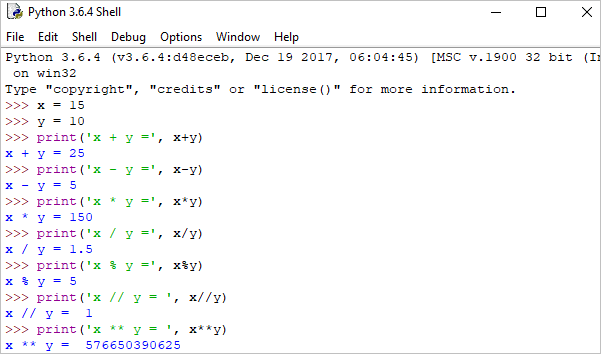
2) Comparison Operators
Comparison operators are used for comparing values. It either returns True or False according to the condition.
| Operators | Definition |
|---|---|
| Greater than (>) | True if left operand is greater than the right |
| Less than (<) | True if left operand is less than the right |
| Equal to (==) | True if both operands are equal |
| Not equal to (!=) | True if operands are not equal |
| Greater than or equal to (>=) | True if left operand is greater than or equal to the right |
| Less than or equal to (<=) | True if left operand is less than or equal to the right |
Example:
- x = 8y = 15(‘x>y is’,x>y)
Output: x > y is False
- print(‘x< y is’, x<y)
Output: x < y is True
- print(‘x == y is’, x==y)
Output: x == y is False
- print(‘x != y is’, x!=y)
Output: x != y is True
- print(‘x >= y is’, x>=y)
Output: x >= y is False
- print(‘x<= y is’, x<=y)
Output: x <= y is True
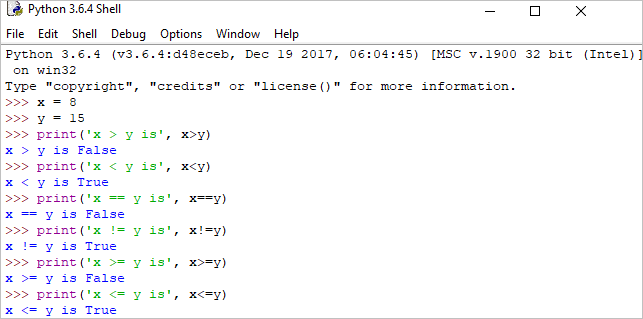
3) Logical Operators
Logical operators are used for performing AND, OR and NOT operations. It either returns True or False according to the condition.
| Operators | Definitions |
|---|---|
| and | True if both the operands are true |
| or | True if either of the operands is true |
| not | True if operand is false |
Example:
- a = Trueb = Falseprint(‘a and b is’, a and b)
Output: a and b is False
- print(‘a or b is’, a or b)
Output: a or b is True
- print(‘not a is’, not a)
Output: not a is False
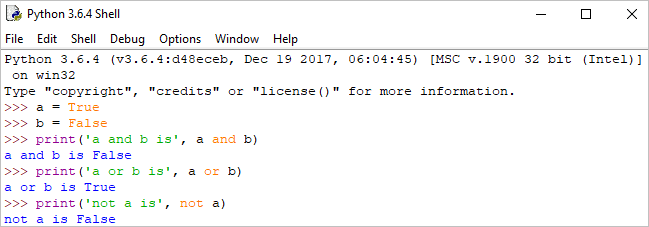
4) Bitwise Operators
Bitwise operators operate on bits and perform bit by bit operation.
| Operators | Definitions |
|---|---|
| & | Bitwise AND |
| | | Bitwise OR |
| ~ | Bitwise NOT |
| ^ | Bitwise XOR |
| >> | Bitwise right shift |
| << | Bitwise left shift |
5) Assignment Operator
An assignment operator is used to assign a value to a variable.
| Operators | Definitions | Output |
|---|---|---|
| = | x = 15 | x = 15 |
| += | x += 15 | x = x + 15 |
| -= | x -= 15 | x = x – 15 |
| *= | x *= 15 | x = x * 15 |
| /= | x /= 15 | x = x / 15 |
| %= | x %= 15 | x = x % 15 |
| //= | x //= 15 | x = x // 15 |
| **= | x **= 15 | x = x ** 15 |
| &= | x &= 15 | x = x & 15 |
| |= | x |= 15 | x = x | 15 |
| ^= | x ^= 15 | x = x ^ 15 |
| >>= | x >>= 15 | x = x >> 15 |
| <<= | x <<= 15 | x = x << 15 |
6) Identity Operators
Python offers 2 types of identity operators i.e is and is not.
Both are used to compare if two values are located on the same part of the memory. Two variables that are equal does not imply that they are identical.
| Operators | Definitions |
|---|---|
| is | True if the operands are identical |
| is not | True if the operands are not identical |
Example:
- a1 = 3b1 = 3a2 = “Python”b2 = “Python” a3 = [4,5,6]b3 = [4,5,6] print(a1 is not b1)
Output: False
- print(a2 is b2)
Output: True
- print(a3 is b3)
Output: False
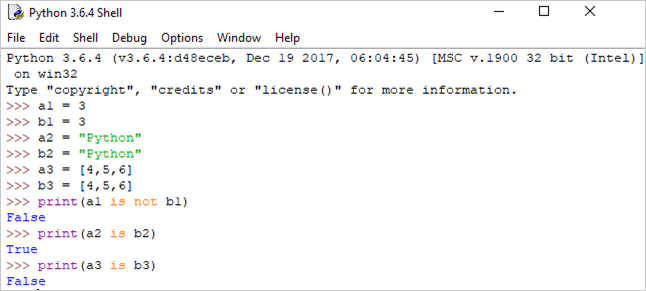
Here a3 and b3 are listed, interpreter allocates memory separately and even though they are equal, it returns False.
7) Membership Operators
Python offers 2 types of membership operators i.e in and not in.
Both are used to test whether a value or variable is in a sequence.
| Operators | Definitions |
|---|---|
| in | True if value is found in the sequence |
| not in | True if value is not found in the sequence |
Example:
- a = “Python operators”b = {1:’x’,2:’y’} print(“P” in a)
Output: True
- print(“python” not in a)
Output: False
- print(1 in b)
Output: True
- print(‘y’ in b)
Output: False
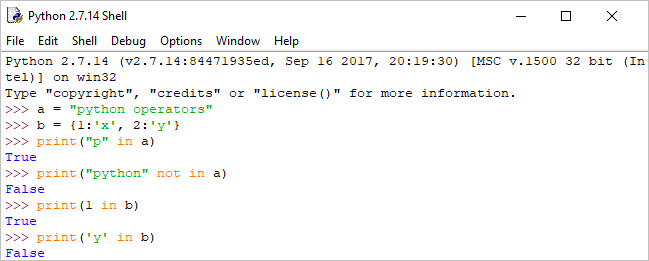
1 is key and ‘x’ is the value in dictionary b. Hence, ‘y’ in b returns False.
Hope you are clear about Python operators and their various types.
Are you looking training with Right Jobs?
Contact Us- Python Functions Tutorial
- Data Structures Cheat Sheet with Python Tutorial
- Python Tutorial
- How to Download Python
- Python Anaconda Tutorial
Related Articles
Popular Courses
- Java Training
11025 Learners - C and C++ Training
12022 Learners - Dot net Training
11141 Learners
- What is Dimension Reduction? | Know the techniques
- Difference between Data Lake vs Data Warehouse: A Complete Guide For Beginners with Best Practices
- What is Dimension Reduction? | Know the techniques
- What does the Yield keyword do and How to use Yield in python ? [ OverView ]
- Agile Sprint Planning | Everything You Need to Know
